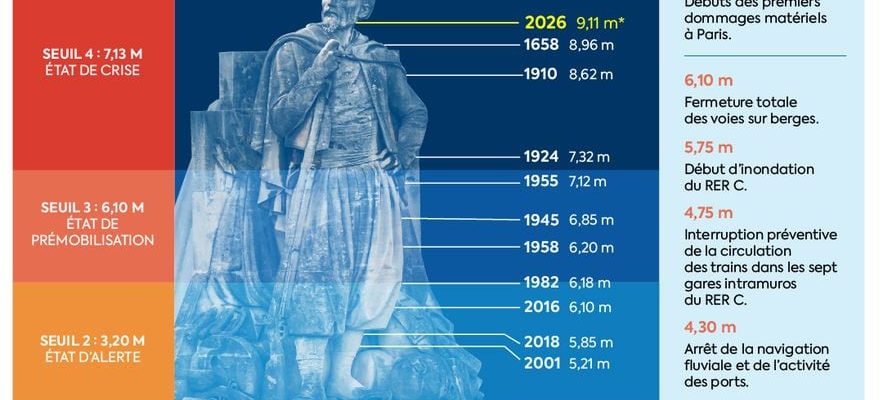Between a region affected by flooding and another affected by historic drought, there are only a thousand kilometers. Paradoxical and striking effect of an ever more disrupted climate, and growing tensions on the country’s water resources. Each summer now imposes its debate on its uses and access, while the sometimes torrential rains of winter ravage certain territories. How can France adapt to this new reality? L’Express wanted to contribute to a debate that is more necessary than ever. These six “black scenarios” for water by 2030 are the translation. They are neither forecasts nor predictions. But hypotheses on which public and industrial authorities are already working more or less directly, and whose frameworks have been refined and enriched by the forty experts interviewed: researchers, meteorologists, senior civil servants, engineers, insurers… All are unanimous: the The country’s resilience in the face of these events is being built now.
On March 12, 2026, makeshift boats circulated painfully on the Place de la Concorde, in Paris, covered with 0.70 meters of water. The Seine has burst its banks for ten days. “In the case of a 100-year flood, it would take between a week and ten days for it to reach its peak,” explains Baptiste Blanchard, general director of Seine Grands Lacs, the public establishment responsible for flood prevention actions. . Since the beginning of the month, downpours have fallen on Ile-de-France and neighboring regions, the ground hardened by frost preventing their infiltration. The four water retention basins upstream of Paris are two-thirds full. “They would manage to reduce the flood by 50 to 70 centimeters,” continues Baptiste Blanchard, “but no more.”
Three days after the start of the rains, the Paris town hall began to close the first lanes on the banks in the 15th arrondissement, then made them inaccessible when the flood reached 6.10 meters. The RATP closes 41 metro stations in the face of rapidly rising water levels. “The task is difficult: in New York, we saw during floods that it was enough for a subway entrance to be open to flood all or part of the underground network,” notes Eric Gaume, director of the geotechnical department at the Gustave-Eiffel University. For several days, public authorities have been warning the population of rising water levels. “In this scenario, the first alert would be given several days before the Seine reaches this historic level, with regular updates,” indicates the Paris police headquarters.
The Zouave and the Alma bridge, lookouts for the Seine floods.
© / The Express
More electricity
Despite the alerts, the rising waters surprise several Ile-de-France residents. On March 11, five people were reported missing. The next day, the flood level exceeded that of 1910, and reached 9.11 meters. The statue of the Zouave on the Pont de l’Alma now has water up to its shoulders. “The extreme population density would make the episode complex to manage. One million people are today in a flood zone,” explains Ludovic Faytre, head of major risks and planning studies at the Paris Region Institute. 5 million people would be directly or indirectly exposed to flooding.” More than 300 communities are flooded. Intramural, the Champs-Elysées, the National Assembly and the Champ-de-Mars are inaccessible without getting wet, like a good part of the 15th, 8th and 12th arrondissements. Around forty health establishments in the capital are affected. Physical protection against flooding is put in place, and electrical pass systems are activated.
“We do not know how to operate electrical structures underwater. Enedis would therefore cut off electricity preventively and as the river rises, sector by sector,” explains Nicolas Perrin, regional director of Enedis Paris In the event of a 100-year flood, these measures could affect around 300,000 of our customers in Ile-de-France.” In total, just over a million Ile-de-France residents no longer have electricity. Drinking water networks are also functioning in a degraded manner. “Very many malfunctions would occur in production plants and distribution in the inner suburbs,” explains Frédéric Gache, deputy director of territorial support at Seine Grands Lacs. For residents in areas where drinking water would no longer be available delivered to the tap, the return to normal is unknown. It would be estimated to take several weeks.” To cope, the State distributes 3 liters of bottled water per day and per person. Mayors and prefects issue evacuation instructions. “Firefighters and emergency services would be heavily mobilized to take care of the most vulnerable groups,” he continues.
The La Défense district, nerve center for many large companies, although not flooded, is also affected. Even with their employees working from home, the impact of the flood is being felt. With a flood of this magnitude, you have to wait a month for the Seine to return to its bed, and for life to gradually return to normal. “Enedis would restore electricity zone by zone at the first signs of recession,” assures Nicolas Perrin. The return to normal takes place over five months. The amount of the loss is estimated at more than 30 billion euros. “We only take into account the direct damage from the flood,” warns Baptiste Blanchard. “The total cost, including indirect damage, should reach 50 billion.”
.
